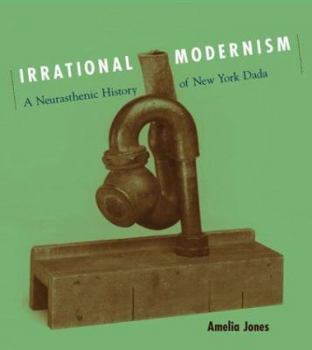Irrational Modernism: A Neurasthenic History of New York Dada
Select Format
Select Condition 
Book Overview
In "Irrational Modernism," Amelia Jones gives us a history of New York Dada, reinterpreted in relation to the life and works of Baroness Elsa von Freytag-Loringhoven. Jones enlarges our conception of New York Dada beyond the male avant-garde heroics of Marcel Duchamp, Man Ray, and Francis Picabia to include the rebellious body of the Baroness. If they practiced Dada, she lived it, with her unorthodox personal life, wild assemblage objects, radical poetry and prose, and the flamboyant self-displays by which she became her own work of art. Through this reinterpretation, Jones not only provides a revisionist history of an art movement but also suggests a new method of art history.Jones argues that the accepted idea of New York Dada as epitomized by Duchamp's readymades and their implicit cultural critique does not take into consideration the contradictions within the movement -- its misogyny, for example -- or the social turmoil of the period caused by industrialization, urbanization, and the upheaval of World War I and its aftermath, which coincided with the Baroness's time in New York (1913-1923). Baroness Elsa, whose appearances in Jones's narrative of New York Dada mirror her volcanic intrusions into the artistic circles of the time, can be seen to embody a new way to understand the history of avant-gardism -- one that embraces the irrational and marginal rather than promoting the canonical.Acknowledging her identification with the Baroness (as a "fellow neurasthenic"), and interrupting her own objective passages of art historical argument with what she describes in her introduction as "bursts of irrationality," Jones explores the interestedness of all art history, and proposes a new "immersive" understanding of history (reflecting the historian's own history) that parallels the irrational immersive trajectory of avant- gardism as practiced by Baroness Elsa.
Format:Hardcover
Language:English
ISBN:0262101025
ISBN13:9780262101028
Release Date:January 2004
Publisher:MIT Press (MA)
Length:334 Pages
Weight:1.60 lbs.
Dimensions:0.9" x 8.3" x 9.2"
Age Range:18 years and up
Grade Range:Postsecondary and higher
Customer Reviews
1 rating
Irrational Art History; or, Queering up Dada
Published by Thriftbooks.com User , 21 years ago
Amelia Jones, author of _Postmodernism and the Engendering of Marcel Duchamp_ and _Body Art_, has (yet again!) pushed the limits of critical theory and historical investigation in art history and visual culture. _Irrational Modernism_, which is Jones's intervention into early twentieth century modernism and studies on Dada, marks the beginning of an embodied and invested art history -- one that moves away from the hegemonic practices of the historians and theorists associated with the journal October. Of course, it almost goes without saying, that Jones's style and theoretical approach is something that only a brilliant feminist and queer art historian could do. It is refreshing to have a history that starts and ends with a woman (the Baroness, et al.), and it is theoretically and historically important to have a history that counters hegemonic discourses and theories in art history (specifically, the ones practiced by east-coast art historians) because the time is right to think "our" way out of the dead-end that has been set up for "us." Indeed, Jones, using the figure of the Baroness and neurasthenia, leads us on a path that takes us away from the traditional roads that have been mapped out before, and Jones situates herself and the reader in an affect that can lead to other ways and modes of being-in-the-world. With Jones and the Baroness, we go on a derive, flaneurie, embodied stroll, and we enter into other worlds and spaces -- as well as other alternative histories and memories -- that de-naturalize the world of Dada as we presently "know" it.It is not difficult to states that this book, _Irrational Modernism_, will be important to anyone doing contemporary and modern art history, critical theory, lgbt studies, and woman's studies. I highly suggest it to anyone who desires to think their way out of the present rut that "we" are in -- the dead-end that art history and visual studies has been facing for some time now. Jones's book asks many questions and gives many answers that can lead us to a more productive space. Without a doubt, this book will be know as a landmark text - the first compelling and productive art historical book on twentieth century art and art history for the twenty-first century, as Nicholas Mirzoeff has stated.





